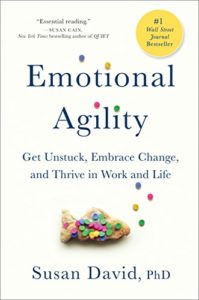Agility can be defined as the ability to move quickly and easily or the ability to think and understand quickly. To be agile can be defined as having a quick, resourceful, and adaptable character. When we put the word agility with the concept of emotions we can see that this must be referring to the ability to effectively understand and respond to emotions.
The problem with emotions is that some people have difficulty in recognizing them, controlling them, or responding to them. For some, emotions can be puzzling, scary, or even crippling. Many emotions have a label as being negative and, therefore, might be thought of negatively. People generally do not like to deal with the negative.
People tend to respond to emotions, especially those negative emotions, in one of three ways. Some people push them away, pretending that they don’t exist or walling themselves off from them. Some people let themselves be captured by emotions, stirring them around and ruminating over them. And others recognize emotions for what they are, signals, and deal with them effectively

In her book, “Emotional Agility”, psychologist Dr. Susan David describes some ways to deal with emotions with what she terms as agility. She labels the first two types of people described above as “bottlers” – they try to put their emotions in a bottle on a shelf – and “brooders” – they keep their emotions active by focusing on them without dealing with them. She describes these people as emotionally rigid while Dr. David’s goal with this book is to equip people to deal comfortably with emotions, to help them become more agile.
The big idea in “Emotional Agility” is that people who are effective or whole do not get “hooked” by emotions. To become more emotionally agile, Dr. David describes five behaviors. No doubt there are other behaviors or thought patterns that can affect our ability to deal effectively with emotions, but her opinion is that these are the most important behaviors leading to emotional agility.
- Showing up. The first logical step toward emotional agility is to face your thoughts, emotions, and behaviors willingly. Some emotions are valid and appropriate, in fact, they may be there to protect or alert us. Others are old bits that are stuck in our minds and triggered by some unrelated or, more precisely, some unconsciously related, event. In either case, the first step in dealing effectively with an emotion is to recognize it and choose to understand it.
- Stepping out. “This next element, after facing your thoughts and emotions, is detaching from and observing them for what they are – just thoughts, just emotions.” The author refers to Victor Frankl’s position that, in order to evaluate emotions, we must first create some space so that we can view them with a non-judgmental perspective and properly evaluate them.
- Walking your why. Continuing with the idea of perspective, once you have recognized, accepted, and then stepped back and examined your thoughts and emotions, the next step is to compare your thoughts and emotions with your long-term values and aspirations. This assumes that you have done the work to first understand your core values. Dr. David spends quite a bit of time talking about core values and how they should guide decisions. This, of course, is a part of personal wholeness.
- Moving on – the tiny tweak principle. The first portion of this chapter is built on the idea that life changes are best done in incremental steps. The author talks of tweaking your mindset, tweaking your motivations, and tweaking your habits. As mentioned above, emotions have a way of triggering behaviors based on some long-buried history. In order to keep from being emotionally hijacked, we need to identify those triggers and then change the course of what happens when certain emotions arise.
- Moving on – the teeter-totter principle. The teeter-totter principle says that wholeness comes in part through maintaining a balance between comfort and challenge. If we spend all of our time in total comfort, we become complacent. If we spend all of our time too far on the challenge side, we become stressed, frazzled, and distracted. The author recommends that be “whelmed”, that is, not overwhelmed but with enough challenge to keep us growing and sharp.
This book was good, not great. The book is very readable and has many good thoughts. It is built on solid research. Much of it seemed to be good practices on the path to wholeness that comes from knowing yourself or what Dr. Henry Cloud describes as “Integrity.” If you are on the path to wholeness, this implies that you have emotional agility, which can be described as the ability to properly understand and collaborate with emotion in a healthy manner.

Add your comment